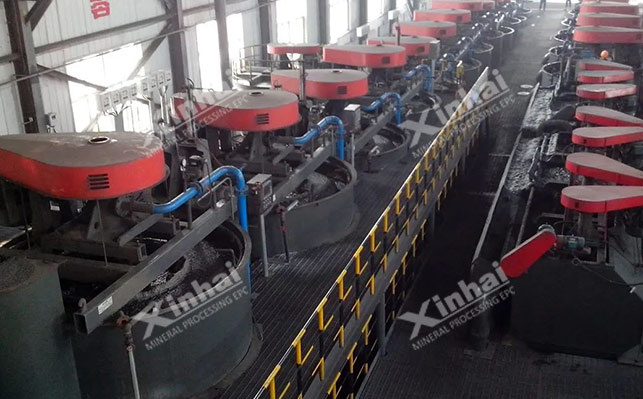Potassium ore is an important raw material for producing potassium fertilizer, and its effective utilization is of great significance for agricultural production. Flotation is one of the important methods for extracting potassium from potassium ores. According to the properties and composition of the ore, there are various commonly used flotation methods for potassium ore. The following are several common flotation methods, required flotation equipment, and flotation reagents, and explain the scope of application of each method.

The positive flotation method is to make the surface of potassium mineral more hydrophilic and less hydrophobic, so that it can be floated into the foam layer to separate from gangue. The commonly used flotation equipment in the positive flotation method is an inflatable mechanical stirring flotation machine, which uses mechanical stirring and air inflation to achieve mineral separation. The positive flotation method is suitable for processing potassium ores containing a large amount of gangue minerals, especially potassium feldspar and other minerals.
The commonly used flotation reagents in the positive flotation method include ① collectors: commonly used fatty acids and amine reagents to enhance the hydrophilicity of potassium minerals; ② Foaming agent: such as terpineol oil, used to generate a stable foam layer.
The reverse flotation method enables gangue minerals to be floated into the foam layer by enhancing their surface hydrophobicity, while potassium minerals are left in the pulp to achieve separation. In terms of flotation equipment, reverse flotation specialized flotation machines are commonly used, which can effectively separate hydrophobic gangue minerals. The reverse flotation method is suitable for processing potassium ores containing a large amount of easily floatable gangue minerals, especially ores with high mineral content such as quartz.
The commonly used flotation reagents in reverse flotation method include ① collectors: cationic collectors, such as quaternary ammonium salts, are used to selectively adsorb on the surface of gangue minerals; ② Foaming agent: usually use methyl isobutyl methanol (MIBC) and other foaming agents to generate foam.
The dual flotation method first performs positive flotation followed by reverse flotation, or vice versa, improves the recovery rate of potassium minerals and concentrate grade through two flotation processes. The requirement for the dual flotation method is to equip two sets of flotation equipment, one for the positive flotation stage and the other for the reverse flotation stage. The dual flotation method is suitable for potassium ores containing complex mineral components, achieving higher mineral separation efficiency through dual flotation.
The commonly used flotation reagents in the dual flotation method include ① collectors: fatty acids are used in the positive flotation stage, and cationic collectors are used in the reverse flotation stage; ② Foaming agent: Both stages can use pine alcohol oil or MIBC.
The hydrochloric acid flotation method involves adding hydrochloric acid to the slurry and adjusting the pH of the slurry to alter the surface properties of potassium minerals and gangue minerals, thereby achieving separation. The flotation equipment suitable for the hydrochloric acid flotation method is generally an acid resistant flotation machine, which can operate stably under acidic conditions. The hydrochloric acid flotation method is suitable for processing potassium ores containing carbonate gangue minerals, and improves mineral separation efficiency through acidic conditions.
The commonly used flotation reagents in hydrochloric acid flotation method include: ① collector: hydrochloric acid is used as a regulator, and fatty acid collectors can also be used; ② Foaming agent: such as pine alcohol oil.
Salt water flotation method is to add a certain concentration of salt water to the slurry, and utilize the influence of ions in the salt water on the surface properties of minerals to enhance the flotation effect of potassium minerals. It is recommended to use a regular flotation machine for flotation equipment, but it is required that the flotation machine has the function of salt corrosion resistance. The saltwater flotation method is suitable for treating potassium ores formed by marine sedimentation, and improving flotation conditions through saltwater environment.
The flotation reagents used in the brine flotation method include: ① collectors: the ions in the brine themselves can serve as regulators, while fatty acid collectors are used; ② Foaming agent: such as pine alcohol oil.
There are various flotation methods for potassium ore, including positive flotation, reverse flotation, double flotation, hydrochloric acid flotation, and brine flotation. Different flotation methods are suitable for different types of potassium ores. By selecting appropriate flotation equipment and reagents, the recovery rate of potassium minerals and concentrate grade can be effectively improved. For specific ore properties and compositions, it is necessary to scientifically select and optimize flotation processes in order to achieve optimal beneficiation results.